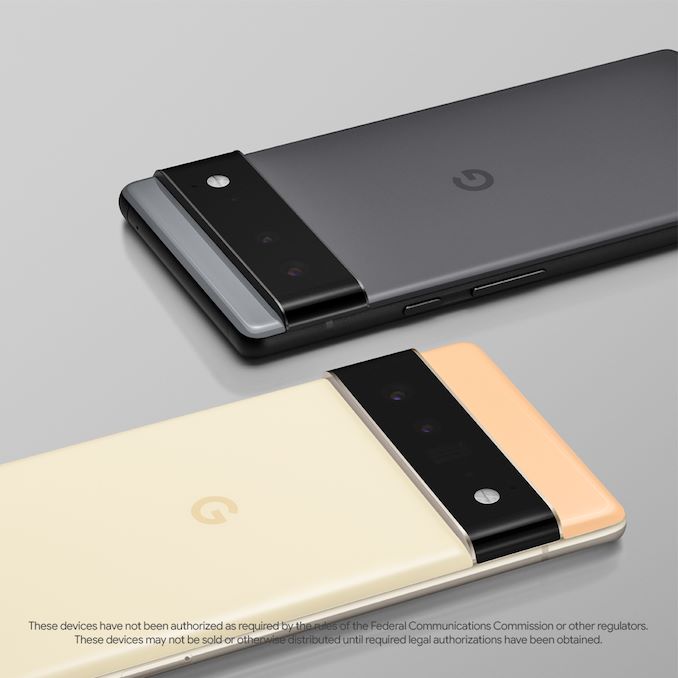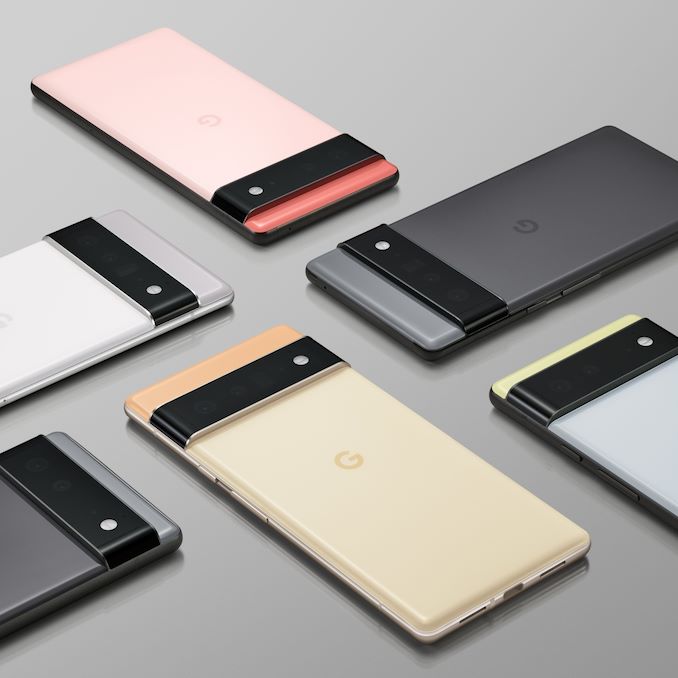Google Teases Pixel 6 and Pixel 6 Pro with new "Tensor" SoC
by Andrei Frumusanu on August 2, 2021 1:55 PM EST- Posted in
- Mobile
- Smartphones
- Pixel 6
- Pixel 6 Pro

Today Google has teased its new upcoming Pixel 6 and Pixel 6 Pro phones; in what is likely an attempt to get leaks and the upcoming narrative of the product under control, as opposed to the previous years of quite severe product spoilers several months ahead of the actual official product launches, the company is themselves revealing large important bits about the upcoming new flagship phones.
Google reveals that this year’s Pixel phones will be called the Pixel 6 and the Pixel 6 Pro, two seemingly similarly sized devices in a high-end configuration with some compromises, and one in an all-bells-and-whistles uncompromising device. In a more exclusive prebriefing with The Verge, it’s stated that the new devices will be truly flagship specced phones competing at the highest end of the market, marking an important step away from the mid-range of the last several years. This is a large shift for Google and has been one of our main criticisms over the last few years – a seeming lack of clear direction where Google wants to be with their Pixel phones, at least until now.
The first big news and confirmation from Google is the fact that the new Pixel 6 phones will be powered by a custom SoC that Google has dubbed the “Google Tensor”. For a few years now it had been rumoured that Google would be the first customer of Samsung LSI’s new semi-custom SoC business – essentially a design and manufacture for hire service that would allow OEMs to work very closely with SLSI in designing differentiated products. Essentially this would be the exact same business model AMD uses in partnership with the console vendors.
What’s interesting here is exactly what’s part Google, and what’s part Samsung LSI and stemming off from the Exynos SoC line-up. The one thing that had been assumed and has been confirmed today is that Google is employing their own AI/ML/NPU IP in the new chip, basically leveraging the company’s experience off their datacentre TPU hardware designs and IP, and integrating it into an SoC. In a sense, this also might be a successor to the Pixel Visual Core, with the large power efficiency and cost savings advantage that Google is now able to integrate it into the primary SoC.
In terms of other specifications of the SoC, there were no further details revealed at this time, but generally given the expected fall release date of the devices, it’s generally to be assumed that the chip would feature the same generation IP blocks in terms of CPU and GPU as other 2021 SoCs such as the Exynos 2100. This wouldn’t be a complete move away from past Pixel device’s release schedule not matching the industry’s IP release cadence – I would still expect the Q1 2022 SoCs to vastly out-spec it, but it’s at least a large improvement thanks to the new hardware differentiation.
The one large question that remains to see is how things play is in terms of the cellular capabilities – notably the device dropping Qualcomm as the preferred chipset vendor would also mean that this would be the only second other design besides Qualcomm featuring mmWave connectivity, which will be interesting to see. Samsung had noted back in 2019 that they had mmWave modules, and although we didn’t see them in 2020, maybe the new Pixel phones will be the first to feature them.
Material You will be best on #Pixel6.
— Made By Google (@madebygoogle) August 2, 2021
The colors, the camera, the form, and what’s on the screen all work together in a single, fluid experience.
(9/13) pic.twitter.com/K6BRF9ZKEY
In terms of the actual Pixel 6 phones, the Pixel 6 is advertised as having a 6.4” screen at a presumably lower FHD+ resolution, with flat glass design, while the Pixel 6 Pro is a 6.7” phone and a presumably QHD+ resolution. Both screens are reportedly 120Hz refresh rate as per the The Verge, though MKHD notes 90Hz on the regular unit.
The design of the new Pixels is defined by what Google describes as the “camera bar”, which is an interesting take on merging the needed camera bump and embracing it into the phone’s design. The large feature is very much unapologetic and horizontally covers the width of the phone, being rounded off to the sides. It somewhat reminds me of the Mi 11 Ultra bump, just much thinner and more subdued.
In terms of cameras, both phones feature an ultra-wide and a regular wide-angle, both with new sensors that are advertised to have much better light gathering capabilities. The Pixel 6 Pro also gets a periscope telephoto module with 4x optical magnification, meaning it’ll end up around 105mm equivalence. Google’s decision to go with a lower focal length here is I think extremely good as it avoids the large quality gap, and if the company employs a high-resolution sensor on the new module, it’ll still be able to have great spatial resolution at >8x magnification.
The camera software and processing are said to be extremely integrated with the new Tensor SoC and the ML IP block of the chip, enabling new features such as using HDRnet in video recording, running the same image pipelines that previously only were possible in still shots.
Google plans to formerly announced and launch the Pixel 6 and Pixel 6 Pro “this fall”.











46 Comments
View All Comments
geo2160 - Tuesday, August 3, 2021 - link
So much mental gymnastics and so much misinformation to prove that >google bad. You don't even have proof for half of your statements.Also, remember this: as soon as smartphones became payment capable devices, security had to become better, much better. Just because you don't use those features doesn't mean they're not important.
mode_13h - Wednesday, August 4, 2021 - link
The thought-experiment I find most troubling would be a ransomware attack on phones. If there were an easily accessible exploit that could enable phones to be hacked, just imagine what would happen if a significant fraction of the population woke up to find their phone bricked, until their carrier or government paid like $1B.mode_13h - Wednesday, August 4, 2021 - link
Any readers of this site will know the difference between a custom ARM core and a Cortex-A that's licensed.As for licensing a custom core from Samsung, frequent readers of this site will also know that Samsung disbanded its ARM core design group, about 2 years ago.
https://www.anandtech.com/show/15061/samsung-to-ce...
Fulljack - Wednesday, August 4, 2021 - link
good things Android™ are open source and most common phones has community support with custom ROM (still based on AOSP) that has cherry picked codes which you can review it according to your use.smartphone are only as dumb as it's users.
imaheadcase - Wednesday, August 4, 2021 - link
You literally listed nothing that is common problem with %99.9 of users. Me thinks you are just a nerd throwing out data that has no real meaning on actual people.Who the hell cares about a SD card slot or headphone jack in 2021? I've never seen a time i needed them. lol
Also that market share stat..uhh what the hell are you talking about. I hardly know anyone with iphones except girls now. Every guy i know has one, and they are not even nerds at all. lol
"always has issues with hardware and software". Ok bud, i guess i've been super lucky to never have a issue then. So much for always right.
mode_13h - Thursday, August 5, 2021 - link
> Who the hell cares about a SD card slot or headphone jack in 2021?I'll admit that I based a phone-buying decision in 2018 because it had a headphone jack. However, once I got Bluetooth headphones that supported AptX HD and Sony's equivalent, I decided their quality was good enough that lowering of the noise floor-lowering by noise cancellation revealed more detail than any fidelity benefits I could get by using even my best corded headphones.
Plus, cords always seem to get in the way or snag on things, unless I'm sitting at my desk. And then, I can just jack into my hi-fi rig.
> i guess i've been super lucky to never have a issue then.
Yeah, any issues I've had tended to be so rare that the only one I can even think of is that an old Nexus phone I had eventually would fail to unlock. That's after I'd had it on for a long time, and it was fixed with a simple reboot. But I'd had it for 3 years and was already in the market for a new phone, anyway.
cha0z_ - Thursday, August 5, 2021 - link
I would actually agree that android slowly, but surely locks down more and more. Instead of alternative of ios, it's really becoming the same but without the benefits of ios. Quite sad, loved the old days when android was more tech savvy OS with a lot of options - linux with a skin with low number of restrictions and easy unlock for total removal of any restrictions.mode_13h - Monday, August 2, 2021 - link
That sensor bar had me hoping it included ToF or structured light, but I don't see anyone saying it does.All the AI stuff in these phone is an anti-feature, specifically *because* it's Google. It just means they have that many more ways to spy on you. For instance, they can use AI to infer from sensors like your accelerometer and microphone a lot about what you're doing, even without engaging the camera. And who's to say they won't use it, as well.
I always disable Google Assistant on my phone, but you can't really be sure they're not still listening to everything you say.
mode_13h - Monday, August 2, 2021 - link
The upside for Google is obvious. Instead of buying and running their own hardware to spy on you, *you* buy it *and* pay for the electricity!abufrejoval - Monday, August 2, 2021 - link
That's progress!From simply "being the product" we advance to "paying to be the product"!